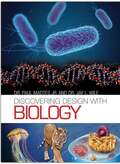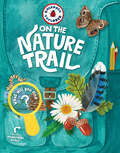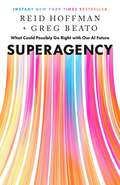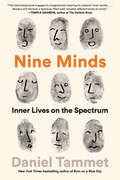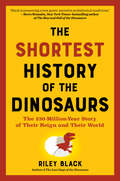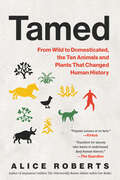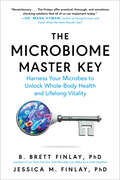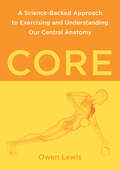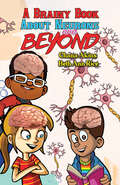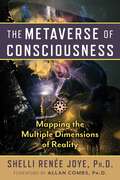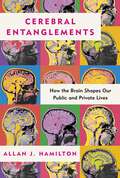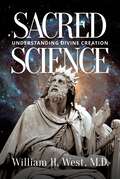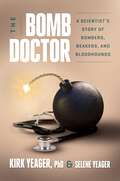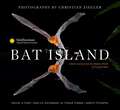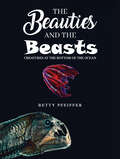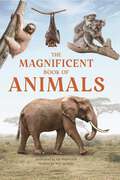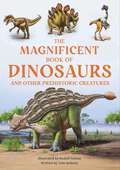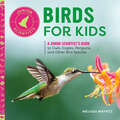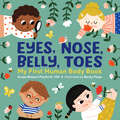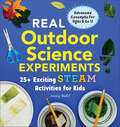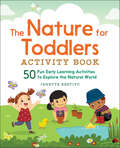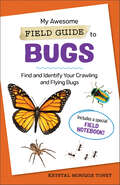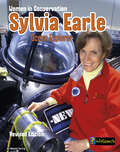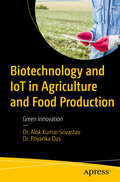- Table View
- List View
A Watershed Runs Through You: Essay, Talks, and Reflections on Salmon, Restoration, and Community
by Freeman HouseThis anthology brings together a selection of essays, articles, and lectures that represent the work of environmentalist Freeman House, whose work built the involvement of local citizens in the restoration of watersheds in northern California. "Consequences flow downstream," he points out, "and we're all in their path." While much of House's work focuses on the restoration of wild salmon populations, he shows how all life is connected and interdependent. His restoration efforts in the Mattole Watershed contain blueprints for restoration efforts everywhere.
Discovering Design with Biology
by Dr Paul Madtes Jr. And Dr. Jay L. WileDiscovering Design with Biology is a laboratory-based high school biology course is the first biology course a college-bound student should take. It gives the student an introduction to how living organisms are designed, how they interact with one another, and how they interact with their physical environment. Students are taught how biologists classify life, the chemical processes that make life possible, the structures of RNA and DNA, and the designs of the different cells found in living organisms. Students also learn the means by which photosynthesis, cellular respiration, and cellular reproduction occur. They then learn the current state of biotechnology. With the molecular and cellular basis of life covered, the students are then given a survey of the different kinds of organisms found in nature: archaea, bacteria, protists, fungi, invertebrates, vertebrates, and plants. The students then learn the biogeochemical cycles that keep environments hospitable to life, which leads to a discussion of ecosystems. Throughout the course, students see that life is the result of design and that organisms have been given the ability to adapt to their surroundings. In addition, they learn various problems associated with the modern evolutionary synthesis.
Backpack Explorer: What Will You Find? (Backpack Explorer)
by Editors of Storey PublishingThis take-along field guide teaches kids to look and listen for nature everywhere, whether in a nature preserve, an urban park, or a suburban backyard. From worms, birds, and spiders to trees, flowers, and clouds, young explorers learn about nature all around them. Find out what different animals eat, how plants grow, and how identify fungi and lichen. It's the perfect guide for kids ages 4 to 8 who love exploring the outdoors. Gold Mom's Choice Award Winner This publication conforms to the EPUB Accessibility specification at WCAG 2.0 Level AA.
Superagency: What Could Possibly Go Right with Our AI Future
by Reid Hoffman Greg BeatoInstant New York Times and USA Today Bestseller. Tech visionary and co-founder of Manas AI Reid Hoffman shares his unique insider’s perspective on an AI-powered future, making the case for its potential to unlock a world of possibilities. <p> "An essential companion." — Fei-Fei Li <p> "An important read." —Bill Gates <p> "Brilliant mind. Compassionate heart. Bold ideas…Read this book!” —Van Jones <p> "Refreshingly optimistic and welcome perspective." — Ariana Huffington <p> "A fascinating and insightful book." —Yuval Noah Harari <p> As taught at UPenn's Wharton and Stanford. Superagency offers a roadmap for using AI inclusively and adaptively to improve our lives and create positive change. While acknowledging challenges like disinformation and potential job changes, the book focuses on AI’s immense potential to increase individual agency and create better outcomes for society as a whole. Imagine AI tutors personalizing education for each child, researchers rapidly discovering cures for diseases like Alzheimer's and cancer, and AI advisors empowering people to navigate complex systems and achieve their goals. Hoffman and co-author, tech and culture writer Greg Beato envision a world where these possibilities, and many more, become a reality. <p> Superagency challenges conventional fears, inviting us to view the future through a lens of opportunity, rather than fear. It’s a call to action – to embrace AI with excitement and actively shape a world where human ingenuity and the power of AI combine to create something extraordinary. Entrepreneur Reid Hoffman is a co-founder of LinkedIn, Inflection AI, and Manas AI. He is also host of the podcasts Possible and Masters of Scale. <b>New York Times Bestseller</b>
Nine Minds: Inner Lives on the Spectrum
by Daniel TammetFrom the New York Times–bestselling author of Born on a Blue Day and Thinking in Numbers, this poignant, perspective-altering book celebrates the power and beauty of the neurodivergent mind, as told through the true stories of nine contemporary men and women on the autism spectrum. “Tammet’s exquisite portraits remind us that the variety of brains is every bit as essential as any other form of diversity.”—Andrew Solomon, author of Far from the Tree Exploding the tired stereotypes of autism, Daniel Tammet—acclaimed author and an autistic savant himself—draws out the inner worlds of nine extraordinary, neurodivergent lives from around the globe. A nonverbal man from Boston explores body language, gesture by eloquent gesture, in his mother’s yoga classes. A Japanese researcher in psychology sets out to measure loneliness while drawing on her own experience of autism. From a Fields Medal–winning mathematician to a murder detective, a pioneering surgeon to a bestselling novelist, each is remarkable in their field, and each is changing how the world sees those on the spectrum. Telling stories as richly diverse as the spectrum itself, this perspective-altering, life-affirming work of narrative nonfiction celebrates the power and beauty of the neurodivergent mind—and the daring freedom with which these individuals have built their lives.
The Shortest History of the Dinosaurs: The 230-Million-Year Story of Their Time on Earth (The Shortest History Series)
by Riley BlackA highlight-reel history of the dinosaurs, told like never before—bringing their world to vivid life in a paleontological detective story The Shortest History of the Dinosaurs tells the 230-million-year epic of these staggeringly fascinating prehistoric creatures, covering their small beginnings, spectacular golden periods, and stunning evolutionary success—before an unthinkable asteroid event brought everything to a screeching halt. But this history digs deeper, using numerous recent fossil discoveries and fresh understandings of genetics and evolution to show how we’ve gleaned so much about a long-lost world from mere fragments of fossil. Marshaling the evidence, award-winning author Riley Black reveals the startling relationships that dinosaurs shared with one another, the land they lived on, and other animal species. By conjuring a more complete picture of Earth in the age of the dinosaurs, she shows us how these massive monsters owe their rise to luck as much as to their cunning—and the many surprising ways they left an indelible mark on their dramatically changing world.
Tamed: From Wild to Domesticated, the Ten Animals and Plants That Changed Human History
by Alice RobertsAn “epic and joyous” (Adam Rutherford) history of our species, using recent scientific discoveries to explore humanity’s domestication of the plants and animals that have allowed human civilization to thrive. “An excellent point of entry for anyone who wants to understand the new deep human history and what it portends.”—The Guardian Dogs became our companions. Wheat fed booming populations. Cattle gave us meat and milk. Corn fueled the growth of empires. Potatoes brought feast and famine. Chickens inspired new branches of science. Rice promised a golden future. Horses gave us strength and speed. Apples provided harvestable sweetness. Humans tamed them all. For hundreds of thousands of years, our ancestors were just one wild species among many, their survival dependent on the whims of nature. Then, gradually, we began to tame the plants and animals all around us—and ourselves. Combining genetics, archaeology, evolutionary biology, and anthropology, Tamed tells the story of the greatest revolution in human history, revealing the fascinating origins of crucial domesticated species and how they, in turn, transformed us. Dogs, our first natural ally, aided Ice Age–era hunters and gatherers. Domesticated horses led to new ideas about hunting and combat in the Eurasian Steppe. The reliability of wheat and corn allowed humans to settle down and build civilizations of unprecedented complexity. As she uncovers the astounding global implications of domestication, Alice Roberts urges us to look again at our relationship with the natural world—and our incredible influence upon it.
The Microbiome Master Key: Harness Your Microbes to Unlock Whole-Body Health and Lifelong Vitality (Second Edition)
by B. Brett Finlay Jessica M. FinlayLearn the secret to whole-body, lifelong health: the teeming world of microbes inside and all around you. Hand sanitizer. Social distancing. Antibiotics. Fending off germs has long been considered one of the cornerstones of good health. But what if better health and more graceful aging actually went hand-in-hand with embracing microbes? Your body is teeming with microbes—not just in the gut, but also on your skin, in your lungs, and beyond. And they impact everything from your sleep, cognition, mood, heart health, and energy to your likelihood of developing many diseases. As groundbreaking new studies are showing, taking care of your microbiome—inside and out—can help you improve your day-to-day health and even help prevent or reverse some of the most common age-related diseases. This eye-opening book breaks down what the latest research says about how the microbiome affects all aspects of physical and mental health—and what you can do about it. Potentially change the trajectory of 9 out of 10 leading causes of death, including heart disease, cancer, lung disease, stroke, Alzheimer’s disease, and diabetes Increase your resistance to pathogens like the flu and COVID-19 Keep your skin soft, healthy, supple, and less wrinkled Stabilize your weight and control blood sugar Improve your physical fitness and strength Fight “inflammaging”—low-grade inflammation that hastens the aging process Get a more restful and rejuvenating night’s sleep Reduce stress and improve mental health—and your long-term quality of life The Microbiome Master Key is an updated and expanded new edition of The Whole-Body Microbiome.
Core: A Science-Backed Approach to Exercising and Understanding Our Central Anatomy
by Owen LewisA holistic, in-depth guide to understanding 'core' strength for therapists, movement professionals, and serious enthusiasts seeking advanced insights into functional training for mental and physical healthHealth magazines, gym-class instructors, and YouTube fitness experts frequently speak of the importance of a strong &“core,&” the muscles at our body&’s center that provide stability and support our movement. We know that improved core function can reduce symptoms of low back pain and pelvic pain, incontinence, and breathing issues. But while the core may be well-known, it is still poorly understood: there is no universally agreed-upon definition of the core or the muscles it comprises. Core adopts a holistic yet practical approach to demystifying the core, considering this crucial muscle group for its physical importance to bodily movement as well as our emotional and spiritual center. Physical therapist Owen Lewis digs into a wide range of metaphors and frameworks used to understand the core—from the Japanese concept of hara, a central storehouse of energy, to the set of specific muscles referenced in fitness studios everywhere. While physical therapy and core-exercise regimens tend to emphasize strength building and stable posture, Lewis argues for an approach that is also flexible, fluid, and adaptable: the same exercises may not be appropriate for every person, and may need to be changed up over time. In some cases, a &“weak&” core may be the result of muscles that are overworked and stressed, and &“good&” posture may create more pain than it prevents. Lewis clearly explains how the core works to manage and transfer the force of movement through the center of the body, building on principles of biotensegrity (how the tension and compression of different muscles creates a balanced structure which distributes stress and strain). The final chapters of the book provide a range of useful, functional training exercises suitable for lay readers but especially helpful as examples for therapists and trainers to use with clients.Lewis emphasizes functional training and underlying principles over a static list of exercises, providing the groundwork for tailored, individual training to improve core function. Supplemented throughout with color photos and a diverse range of models, Core makes it easy to understand the anatomy of this crucial region of the body, as well as key principles for more effective and safe exercises and training regimens.
A Brainy Book about Neurons and Beyond
by Chana AkinsThe brain is one of most exciting and complex organs in the universe. In this interactive book, you&’ll learn what the brain is made of, what it does, and how it works!This book includes cool trivia, real and lively illustrations, and fun-filled do-it-yourself activities.
The Metaverse of Consciousness: Mapping the Multiple Dimensions of Reality
by Shelli Renée Joye• Develops the concept of the metaverse, the &“transcendental universe,&” composed of additional hidden dimensions operating in parallel with space and time• Integrates and maps the theories of consciousness developed by Carl Jung, David Bohm, Pierre Teilhard de Chardin, and other scientists• Offers the reader a path into the hidden dimensions through detailed maps of psyche, mind, and cosmosThe "metaverse"—as this wider universe is now coming to be known—is rooted in one interconnected consciousness that encompasses space and time as well as previously unknown dimensions only recently detected. In this book, Shelli Renée Joye, Ph.D., offers ways in which to visualize, enter, and explore a multitude of these transcendent, nonspatial, and nontemporal states and stages of consciousness as she reveals vast webs of interlinked consciousness forming a single universal psyche.Joye integrates the ideas of modern scientist-philosophers who view reality as a projection of a single multidimensional consciousness: Carl Jung and his concept of the psychoids, Pierre Teilhard de Chardin and his vision of an integrated noosphere of consciousness, and the quantum maps of consciousness developed by Karl Pribram and David Bohm. The book culminates with a call to explore transcendental consciousness by developing and following our own uniquely personal paths with which we too can enter the wider dimensions of awareness in the metaverse.
Cerebral Entanglements: How the Brain Shapes Our Public and Private Lives
by Allan J. HamiltonA profound and profoundly important book that, using the most up-to-date revolutionary discoveries in neuroscience, shows us how to understand the brain; how it allows us to think, feel, experience and perceive, written by an acclaimed Harvard-trained neurosurgeon.It took a brain surgeon who&’s spent a lifetime in the operating room experiencing the brain's union of form and function to write this book. Cerebral Entanglements, unlike most books on the brain, looks at the intimate and vital emotions in our lives, and shows as well, how neuroimaging studies can transform our understanding of crucial emotional or mental health concerns. Why do we love? Why do we hate? Why do we kill? Why do we laugh? Why do we have faith? Why does time stand still or speed up? Focusing on the nature of consciousness, affection, trust, romance, empathy, kindness; prejudice, sadness, happiness, depression, grief, and the nature of laughter, the author shows us how neuroscience has changed our understanding of these emotions as he explores the extraordinary revelations that have emerged from brain imaging and functional studies. We see that we are the first generation to perceive the contours of a human thought, track the course of an emotion, even watch memory come together. Allan Hamilton writes clearly and accessibly, about the complex science driving our emotions and experiences, and shows how our newfound knowledge can impact our well-being, individually and as a society. As the book explores the nature of happiness, laughter, stress, PTSD. Hamilton writes about how the brain perceives and experiences music, memory, and time itself.
Sacred Science: Understanding Divine Creation
by William H. WestIf you review of the impulses that created the universe, directed the unfolding of life, and empowered human consciousness you reach an undeniable conclusion: an omnipotent Creator supervised the unfolding of our universe.From the moment of creation to the emergence of a planet tailor-made for life, from the journey of multi-million species to the development of an upright creature hungry for God, science tells a sacred story: a superintelligent Creator used His mathematical genius to convert lifeless equations into galaxies, planets, and people. His love has been visible throughout the process. Could our journey reflect thousands of random accidents with no divine guidance? Creation delivered impulses that filled the universe with galaxies and stars. Eliminate any one of those blueprints and the universe would have been stillborn. Stars produced a perfect mix of elements to bring the universe to life. Without a robust ensemble of gene and protein sequences, life might still be living at the bottom of the sea. Hundreds of human genes convert the neurons of a human infant into trillions of networks in an adult brain. Without those God-given genes, a dangerous world may have left us trapped in the treetops with no interest in science at all. But God shared His mind and triggered the emergence of human consciousness. Where do we find ourselves after centuries of that scientific searching? We see that science reflets its source. Science is a gift of God&’s creative love, and is nothing less than sacred!
The Bomb Doctor: A Scientist's Story of Bombers, Beakers, and Bloodhounds
by Selene Yeager Kirk YeagerA rare peek behind the curtain into boots-on-the-ground, in-the-lab scientific bomb forensics—told with humanity, heart, and even a bit of humor.This is not CSI. What you encounter as a true bomb detective—or &“Bomb Doctor,&” as some in the FBI call me—are fields of twisted metal containing soot-covered fragments intermingled with human remains. You have carnage and chaos. As you wade into that sea of wailing sirens and screaming survivors awash with the stench of diesel fuel and decaying bodies, your job is to ferret out forensic clues in a type of macabre scavenger hunt to ultimately reconstruct the scene and the explosive device and determine what happened and what the bomb looked like before it was torn asunder. None of this happens overnight. Nor does it happen in a timeframe that can be neatly packaged in an hour-long made-for-TV drama. The scavenger hunt can take months—or, in the case of the infamous Collar Bomber, seven painstaking years. The work is worth every second and every horrific image that etches itself into your brain because it helps prevent new horrors. Not all, obviously. We are not superheroes. But unlike shooters, who often just &“snap&” or seem to act out in random ways, bombers almost always have a story—one that follows an arc. In The Bomb Doctor, my goal is to explain that arc, explode myths, reconstruct reality, and build an understanding of the reason and means behind the mayhem, as well as pull back the curtain on the investigative process that brings bombers to justice.
Bat Island: A Rare Journey into the Hidden World of Tropical Bats
by Dr. Rachel A. Page Dr. Dina K. Dechmann Dr. M. Teague O'Mara Dr. Marco Tschapka The Smithsonian Tropical Research InstituteFeaturing incredible photography and insight from an international team with long-term ties to the Smithsonian Tropical Research Institute, Bat Island spotlights the unique beauty and environmental importance of the seventy-six species of bats on Panama&’s Barro Colorado Island.For decades, scientists at the Smithsonian Tropical Research Institute have studied the remarkable biodiversity of bats on Barro Colorado Island in Panama, where an astonishing seventy-six species coexist. Now, for the first time, Smithsonian scientists&’ expertise pairs with the stunning photography of National Geographic contributor Christian Ziegler for a captivating visual journey into the fascinating world of these elusive night creatures. Bats are unique among mammals: they have acquired true flight, provide essential ecosystem services, and represent the ecologically most diverse group of mammals worldwide. Synthesizing decades-worth of intensive study, Drs. Rachel Page, Dina Dechmann, Teague O&’Mara, and Marco Tschapka provide authoritative insight alongside 150 photographs that showcase bats&’ extraordinary environmental adaptations and rich natural history. OVER 150 STUNNING PHOTOGRAPHS: National Geographic photographer and contributor Christian Ziegler has captured over a decade&’s worth of images of the myriad of bat species living on Barro Colorado Island that capture these elusive animals in a variety of settings, from night shots of flight through the tropical rainforest to closeups of their remarkable wings and feeding patterns. WRITTEN BY SMITHSONIAN SCIENTISTS: All chapters of Bat Island are written by scientists long affiliated with the Smithsonian Tropical Research Institute, one of the world&’s leading tropical research organizations that spans a century. Topics include bats&’ diverse sensory abilities, foraging strategies, roosting ecologies, and social systems. DECADES OF CUTTING-EDGE RESEARCH: Bat Island, published in partnership with the Smithsonian, presents fascinating insights from scientists working at the Smithsonian Tropical Research Institute, which boasts decades of study of the hyperdiverse bat population on Barro Colorado Island in addition to the most comprehensive and long-term datasets on tropical bats. CALL FOR CONSERVATION: Drs. Page, Dechmann, O&’Mara, and Tschapka highlight how bats are threatened by habit fragmentation and land degradation, and communicate the initiatives needed to ensure the survival of these animals, which are critical to maintaining healthy, balanced ecosystems. RARE BEAUTY: Award-winning photojournalist Christian Ziegler&’s photography illuminates the unique beauty and allure of bats and the tropical rainforest in Panama.
The Beauties and The Beasts: Creatures At the Bottom of the Ocean
by Betty PfeifferWhen do you know someone best? When you read their biography or when you have a conversation with them? Of course, it&’s when you have a one-on-one visit. Go down in a submersible, the HOV (Human Occupied Vehicle) Alvin, to make the journey to their home. You&’ll meet the weird, the cute, the flashy, and the fierce creatures of the deep.In this book, you won&’t just read a bunch of facts about these remarkable animals—you can learn to know them personally. They&’ll talk to you about themselves, their relatives, and their enemies. As a surprise bonus, you will find out about the many ways your new friends are helping us solve some of our medical problems.Suppose you are interested in learning more about what happens in the ocean. In that case, two people (real people) will tell you what they were like at your age and what motivated them to make the ocean, which covers about 70 percent of the earth&’s surface, their life&’s work.
The Magnificent Book of Animals (The Magnificent Book of)
by Tom JacksonJourney into the wilderness to get up close to the world&’s most magnificent animals in this beautifully illustrated reference book filled with fascinating facts.The Magnificent Book of Animals takes you across the globe, from the Arctic tundra to the African savanna, to meet 36 fascinating animals. From the tiny Rondo dwarf bush baby to the massive white rhinoceros, this book depicts some of the world&’s most incredible animals in stunning and accurate original illustrations. Intriguing facts accompany every illustration, so you can learn how a tiger marks its territory, why a polar bear isn&’t really white, and how long a giraffe&’s tongue actually is. This is the perfect book for animal lovers everywhere. 36 ANIMALS: Learn about dozens of animals from all over the world, from the snow leopard to the flying fox. BEAUTIFULLY ILLUSTRATED: Vibrant, detailed images bring these incredible animals to life. FASCINATING FACTS: Includes hundreds of fascinating facts in an easy-to-read Layout that will excite animal lovers of all ages. MAP OF THE ANIMAL WORLD: A full-page color map shows where each animal originates. COLLECT THE SERIES: More beautifully illustrated collections for all ages include The Magnificent Book of Cats, The Magnificent Book of Sharks, The Magnificent Book of Horses, The Magnificent Book of Birds, and The Magnificent Book of Extinct Animals.
The Magnificent Book of Dinosaurs (The Magnificent Book of)
by Tom JacksonThe Magnificent Book of Dinosaurs takes you back to prehistoric times to meet 36 incredible beasts. From the terrifying T. rex to the speedy Velociraptor, this book depicts some of the most incredible dinosaurs in stunning and accurate original illustrations. Intriguing facts accompany every illustration, so you can learn which is the largest land predator ever found, how the feathered Deinonychus kept its huge hooked claws sharp, and why Triceratops had a large bony frill. This is the perfect book for dinosaur-lovers everywhere. 36 DINOSAURS: Learn about dozens of dinosaurs from all over the world, from the stealthy Spinosaurus to the mighty Dreadnoughtus. BEAUTIFULLY ILLUSTRATED: Vibrant, detailed images bring these incredible beasts to back to life. FASCINATING FACTS: Includes hundreds of fascinating facts in an easy-to-read Layout that will excite dinosaur-lovers of all ages. MAP OF THE DINOSAUR WORLD: A full-page color map shows where each dinosaur originates. COLLECT THE SERIES: More beautifully illustrated collections for all ages include The Magnificent Book of Extinct Animals, The Magnificent Book of Cats, The Magnificent Book of Sharks, The Magnificent Book of Horses, and The Magnificent Book of Birds.
Birds for Kids: A Junior Scientist's Guide to Owls, Eagles, Penguins, and Other Bird Species (Junior Scientists)
by Melissa MayntzExplore the wild and wonderful world of birds with the Junior Scientists series for kids ages 6 to 9From tiny hummingbirds to powerful eagles and everything in between—our planet is home to so many beautifully feathered friends! This big book of birds is packed with tons of cool facts and colorful photos that offer a fascinating peek into their lives. It's written especially for curious new readers, with engaging trivia and age-appropriate language that lets kids read and explore independently as they learn all about birds!35 birds to meet— Kids will discover a variety of bird species like flamingos, penguins, and barn swallows, and find out what they look like, where they live, what they eat, and more.Fun facts—Keep young readers fascinated with cool facts about how baby birds are born, if birds can get lost when they fly, and which water bird eats baby alligators!Learning in action— You'll even find some activities to try, like helping your child measure their own wingspan, build a nest, and spotting your backyard birds.Get ready for an exciting journey through the lives of our beaked buddies in this ultimate bird book for kids.
Eyes, Nose, Belly, Toes: My First Human Body Book
by Krupa Bhojani Playforth MDAll about the human body for kids 1 to 3!"All kids will see themselves in this beautiful book, intentionally designed to help toddlers learn about the amazing things their bodies can do." — Emily Oster, CEO of ParentData and bestselling author of Expecting Better, Cribsheet, and The Family Firm.Learning how the human body works is an important skill for toddlers. This adorable kids anatomy book walks them through every major body part, with simple language and vibrant artwork that keep them engaged as they explore how they use their eyes to see, their nose to smell, their legs to move, and their arms to wave hello!Colorful illustrations—Read along with your child and explore exciting pictures that show kids the body parts they use at playtime, bathtime, snacktime, and more.Which body part is that?—Help your child learn to point out their belly button, count their fingers and touch their elbows!Learning and growing—Make it fun for kids to learn body vocabulary and start to discover all the amazing things their bodies can do.Get this book today and enjoy educational quality time with your child.
Real Outdoor Science Experiments: 25+ Esciting STEAM Activities for Kids (Real Science Experiments)
by Jenny BallifHypothesis: You'll love these real outdoor experiments for kids 8 to 12!Dive into the world's most exciting science project—the great outdoors! Covering everything from plants and trees to rocks and weather, this amazing book has real outdoor science experiments for kids, to immerse you in the wonders of science, technology, engineering, art, and math. Discover STEAM outdoors—Learn how the scientific method can help you unlock the secrets of the natural world. Make nature your laboratory—Conduct 30 cool experiments like creating grass ropes, making ink from plants, calculating latitude by the stars, and more. Find answers to your questions—How do sinkholes form? Are leaves in the shade bigger or smaller than leaves in the sun? Get explanations for the science behind each experiment, plus ideas for taking your experiments even further. Get ready to explore the science happening all around you with Real Outdoor Science Experiments.
The Nature for Toddlers Activity Book: 50 Fun Early Learning Activities to Explore the Natural World
by Jenette RestivoGo exploring with 50 outdoor activities for toddlers!Nature is full of sights, sounds, and textures to fascinate toddlers and engage their growing minds. Encourage them to discover the world around them with this book of hands-on nature activities. From Rainy Day Puddle Stomping to Rock Stacking and Creating a Bird Feeding Station, your little one will practice key skills as they build a love of the great outdoors. Learning in action—Watch as your toddler begins to ask questions, recognize cause and effect, sort objects, and develop their motor skills. Anytime and anywhere—Most of these activities only take about 20 minutes, use basic household items, and can be done in your backyard, your local park, or around the neighborhood. Every part of nature—Dig into activities that teach toddlers about weather and seasons, soil and rocks, creatures and critters, and green things that grow! Get little ones excited to get outside w ith The Nature for Toddlers Activity Book.
My Awesome Field Guide to Bugs: Find and Identify Your Crawling and Flying Bugs (My Awesome Field Guide for Kids)
by Krystal Monique ToneyExplore entomology with this hands-on bug guide for kids 8 to 12 From the butterflies in the sky to the beetles underground, there are more than one million species of bugs that live all around us! Discover what makes them so weird and wonderful with this awesome field guide to the bugs you see every day. You'll learn how to find them, identify them, and keep a log of your adventures—just like a scientist.Which bug is this?—Meet 140 bugs native to the U.S. and Canada, and explore step-by-step instructions for how to tell them apart.Amazing facts and photos—See your favorite bugs up close with detailed pictures of every thorax and antenna, plus fun trivia about what bugs eat, how they behave, and more.Your official field notebook—Record all your bug-hunting data with special pages for logging the bugs you encounter.Grab this bug book today, and learn how to spot and understand our insect, arachnid, crustacean, and myriapod friends.
Sylvia Earle: Ocean Explorer (Women in Conservation)
by Dennis FertigThis book takes an engaging look at the work of ground-breaking conservationist, Sylvia Earle, and her work to protect oceans and ocean life. It covers Earle's inspiration, her methods, findings, and the impact of her work.
Biotechnology and IoT in Agriculture and Food Production: Green Innovation
by Dr. Alok Srivastav Dr. Priyanka DasExplore the transformative intersection of biotechnology and the Internet of Things (IoT) in modern agriculture. This book delves into sustainable solutions and cutting-edge technologies that are revolutionizing the global food production industry. The book is structured to provide an in-depth understanding of how green innovation is reshaping agriculture. Starting with an introduction to sustainability in agriculture, it traces the evolution from traditional farming to smart farming methods, where IoT and Biotechnology come together to optimize crop management, soil health, and resource utilization. Key chapters include the role of IoT in precision farming, biotechnology advancements like CRISPR and GMOs, and their integration for improved crop resilience, pest control, and water management. The synergy between IoT's real-time data capabilities and biotechnology's genetic innovations is highlighted in smart greenhouses, vertical farming, and climate-resilient agriculture. Other critical topics include reducing food waste through technology, the role of AI and machine learning in agricultural practices, blockchain for supply chain transparency, and Biotech's impact on livestock management. Ethical considerations, regulatory frameworks, and green finance opportunities are also addressed, alongside future trends like 5G, drones, and synthetic biology. You will gain a comprehensive view of how biotechnology and IoT are driving sustainable agricultural practices, fostering innovation, and offering solutions to global food security challenges. The book offers practical insights into the future of farming and policy recommendations to ensure a sustainable, tech-driven agricultural future. You Will • Learn how data analytics, AI, and biotech innovations work together in precision farming, optimizing resource usage, improving yields, and addressing environmental challenges • Discover innovative solutions for sustainable food production, including smart irrigation systems, IoT-enabled greenhouses, vertical farming, and biotechnological methods for improving soil health and reducing food waste • Understand the ethical concerns, privacy issues, and regulatory frameworks that govern the use of IoT and biotechnology in agriculture Who Is This Book For Readers with a foundational understanding of agriculture, technology, or sustainability, though no specialized expertise is required. Beginners with an interest in how technology is reshaping food production can grasp the concepts, as the book breaks down complex topics into accessible language. A basic familiarity with IoT and biotech will enhance the learning experience but is not essential for following the book&’s key ideas.

